This is my second year as General of the East Kingdom Rapier Army and I wanted to do something special for my immediate staff who put in a lot of hard work and effort over the year as well as during Pennsic. They take time out of their vacation to deal with me, do bunch of Woods Walks, come to a ton of meetings, etc. Being on Command Staff is fun but it’s also work that takes one away from other Pennsic fun.
Last year I “paid” my staff with replica French coins that I bought at a vendor at Pennsic. This year I decided to write officer commissions to official recognize their role on my command staff and as leaders in the East Kingdom Rapier Army.
The Research
I didn’t have a ton of time to do a lot of research for this project, though I had gone hunting for 17th Century extant army officers’ commissions in the past and came up empty. Apparently extant examples are rare.
This time, however, I did get a little lucky. I stumbled across this blog post by Helion & Company (an English publisher specializing in military history). The post was an example of an amazingly intact officer commission from the English Civil War in 1659.
The commission is for a Captain Thomas Else. The blog post has more details into who Else was and the politics of England when the commission was penned. Else’s commission was the basis of my officer commissions for my Kingdom Executive Officers and my Regional Commanders.
My Champ Coordinators and my Aide de Camp also got commissions, but they differed. They got 15th century English Commissions of Array. A commissions of array was a medieval method of raising troops in which a king grants lords of counties powers to raise military forces emergencies. It fell out of favor by the end of the Elizabethan era, but was brought back by Charles I during the English Civil Wars.
The Champ Coordinators and Aide de Camp’s commissions were inspired by commissions of array from the Glendower Rebellion of 1403 aka Glyndŵr Rising.
Officer Commissions & Commissions of Array Text
Before we dive into what the commissions I wrote look like, let’s look at the text from the examples I worked off of look like.
Captain Thomas Else, Officer’s Commission Text
The Parliament of the Commonwealth of England, Doe Constitute and appointe you Thomas Else and you are hereby Constituted and appointed Captain of a Troop of Horse in the Regiment whereof Lieutenant Generall ffleetwood is Colonell raised and maintained under the Comand of the Parliament for the service of the Commonwealth. You are therefore to take into your Charge and care the said Troope as Captain thereof and duly to Exercise the inferior Officers and Souldiers of the same in Armes and to use yor best Care and endeavor to keep them in good Order and Discipline, Commanding them to obey you as theire Captaine : And you are likewise to observe and follow such Orders and directions as you shall from time to time receive from the Parliament or Council of State appointed by Parliament. And also you are to obey the Superior Officers of the said Regiment and Army according to the discipline of war. In pursuance of the Trust reposed in you and of yor Duty to the Parliament and Commonwealth. GIVEN at Westminster the Ninth day of July In the yeare of Our Lord One Thousand six hundred fifty Nyne.
Signed in the Name of the Parliamt of the Commonwealth of England
Wm Lenthall
Speaker
To Captain Thomas Else
The commission calls out the person who’s being commissioned (Else), his new military title, his troop and regiment, and under who’s command he answers to. The commission also talks about Else’s duties and responsibilities as captain.
And for the 15th Century commission of array.
Glendower Rebellion, Gloucester Commissions of Array Text
Commission to Maurice Russell, Gilbert Dynys, John Rolves and John Harsefelde to assemble all the able fencible men, footmen and horsemen, of the hundreds of Barton Regis by Bristol, Hembury, Pokelchurche, Thornbury, Grymboldesasshe, Berkeley and Whiston and bring them sufficiently armed to the town of Chepstowe by Thursday next at the latest to go with the King or his lieutenant to Wales to resist the rebels bringing with them victuals for 4 days and to take horses from those who have them who cannot labour and deliver them to those who can labour but lack horses. By K.
This commission is much shorter in length than the Else officer’s commission and is pretty straight to the point. Raise troops and meet at this location by this date with this many days of rations. This felt pretty in line with the tone for Champs and made it so I wasn’t just writing cookie-cutter commissions for everyone.
Recreating the Officer’s Commissions & Commissions of Array
From there I wrote up my own commissions, using the example text as my base and changing things to make sense for my staff’s individual roles and this fun little game we all play.
Executive Officers & Regional Commander Commissions Text
The General of the Kingdom of the East, Doe Constitute and appointe you INSERT NAME and you are hereby Constituted and appointed POSITION of ARMY-NAME to raise and maintain Troopes for the service of the Kingdom. You are therefore to take into your Charge and care the said Troope as POSITION thereof and duly to Exercise the inferior Officers and Souldiers of the same in Armes and to use yor best Care and endeavor to keep them in good Order and Discipline, Commanding them to obey you as theire POSITION : And you are likewise to observe and follow such Orders and directions as you shall from time to time receive from the Kingdom or the General appointed by Their Majesties. And also you are to obey the Superior Officers of the said Army according to the discipline of war. In pursuance of the Trust reposed in you and of yor Duty to the Kingdom. GIVEN at Great Northeast War the Fourteenth day of July In the yeare of Anno Societatis LII.
Signed in the Name of of the Kingdom of the East
Maréchal Remy Delamontagne de Gascogne
General
To RECIPIENT
Pretty straight forward changes from the original text.
Champs Coordinators & Aide de Camp Commissions Text
The General of the Kingdom of the East, Doe Constitute and appointe you INSERT NAME and you are hereby Constituted and appointed POSITION of Rapier Champions to assemble all the able fencible swordfighters, duelists and rapier combatants, of nine Easterners and nine Allies and bring them sufficiently armed to the Kingdom of Æthelmearc by Sunday August Fifth at the latest to go with the King and Queen to display Honor, Prowess & Discipline, bringing with them victuals for 7 days and to take part in the great Pennsic War. In pursuance of the Trust reposed in you and of yor Duty to the Kingdom. GIVEN at Great Northeast War the Fourteenth day of July In the yeare of Anno Societatis LII.
Signed in the Name of of the Kingdom of the East
Maréchal Remy Delamontagne de Gascogne
General
To RECIPIENT
You’ll note that I also added some of the Else officer commission text to the commission of array. The Aide de Camp version switches out “Rapier Champions” for “East Kingdom Rapier Army.”
My script/handwriting isn’t really based on anything specific. I tried making some of the letters look fancy and “period” and for the rest I just my usual handwriting. It was important to me for these commissions to feel natural. Mr. Lenthall had much better handwriting in his commission to Else than I do for my officers, but c’est la vie. This was for fun more than a serious A&S project.
I did draw lines in pencil which is present in the Captain Else commission. You can see the faint lines on the paper, so I didn’t erase my lines either. I also tried matching the placement of the text to match the Else commission. And I used ink and a quill pen, which was a fun and new adventure.
The main change I made aesthetically between the two is that I added a wax stamp of my arms next to my signature. This was mostly because I had gotten a new seal & stamp set a few weeks prior and wanted to play with it. I also felt like it added a bit of officialness to the documents and a little color/imagery to spice it up a little. My margins also are much different than the Else commission.
After the commissions were written, dried and stamped with my seal, it was time to fold the commissions. I decided on folding instead of rolling or leaving flat for two reasons:
- The Thomas Else commission was clearly folded at one point.
- I imagined these orders/commissions would be transported through the mail and therefore would be folded for easier transport and security.
I did a bunch of Internet sleuthing to try to find a 17th Century-style folding technique. I came up empty there but what I found was a letterlocking style called tuck and seal from Italy, 1580s. Close enough for this project.
It’s a pretty simple letterlocking technique that includes just a few folds and then sealing it with sealed wax. Easy to learn and seems reasonable that, as a busy General, I might use a method similar to this when sending out my missives to my staff and commanders.
Of course, this is a bit of an assumption on my half, but ¯\_(ツ)_/¯.
The commissions were all handed out at GNEW except for one commander who wasn’t present. They’ll get theirs at Pennsic. Better late than never. 🙂
Gallery
Here’s a handful of pics I took of the project.
Notes
The Thomas Else Commission is 14″x10.5″, ink on vellum. No clue about the Gloucester commissions of array. The commissions I wrote up for my staff are 19″x12.5″, ink on craft paper that looked good enough for the job. 🙂
Thus far, I don’t think anyone has attempted to purchase or sell the officer commissions…
Sources:
Stephen EdeBorrett, English Civil War: The Commission of Thomas Else, 1659 (Helion & Company)
URL: http://blog.helion.co.uk/the-commission-of-thomas-else-1659/
Commissions of Array (BCW Project)
URL: http://bcw-project.org/church-and-state/first-civil-war/commissions-of-array
Commission of array (Wikipedia)
URL: https://en.wikipedia.org/wiki/Commission_of_array
Cal. Patent Rolls, Membrane 20, 1403, 7 Oct. Gloucester.
Letterlocking Videos, Letterlocking: ‘Tuck and Seal’, Italy (1580s), Jan 28, 2014 (Youtube)
URL: https://youtu.be/pje3bxJ_9QY



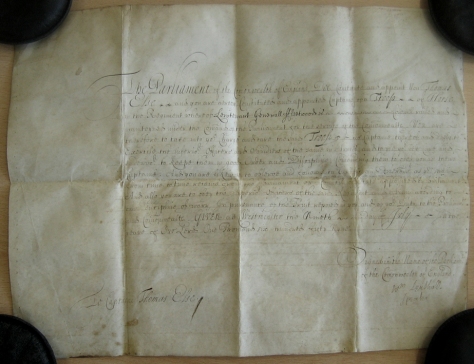

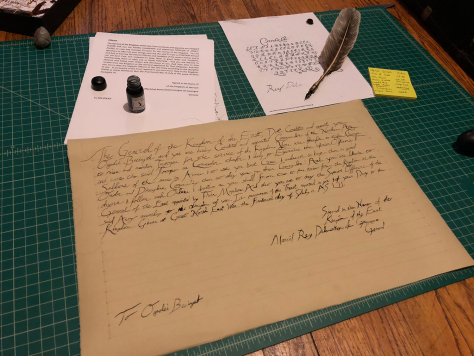


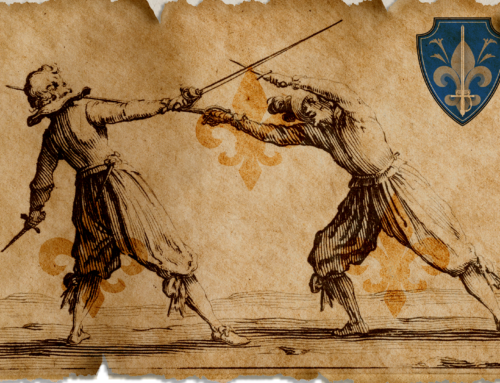


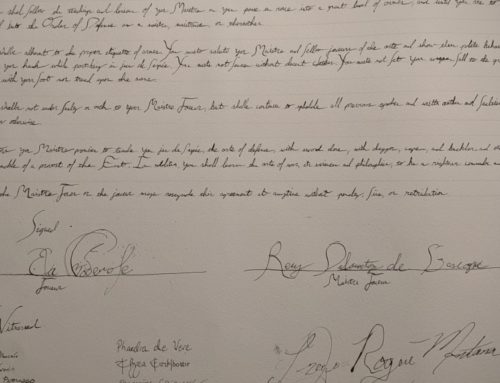
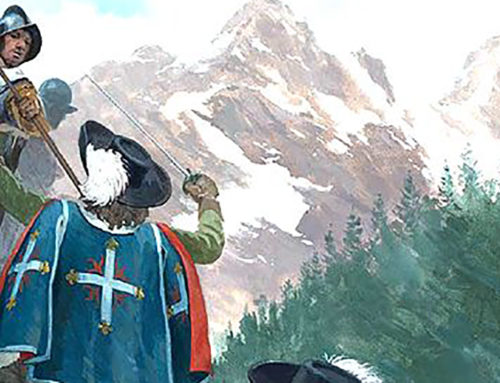
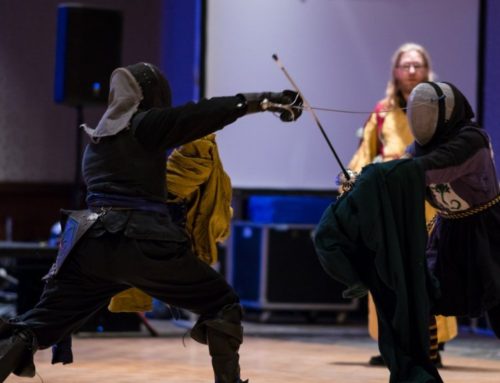
So cool. Nice work here Marshal.
Thanks, mate!